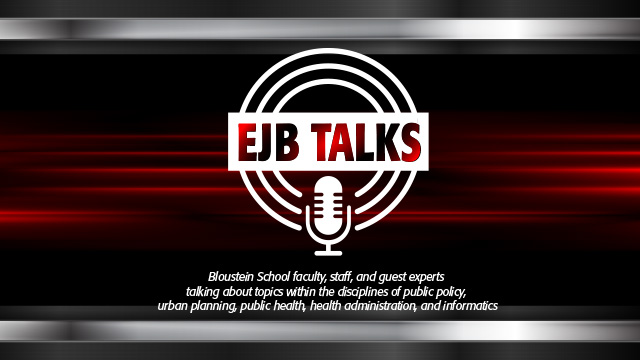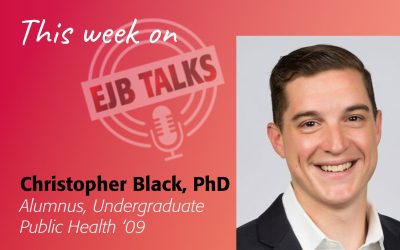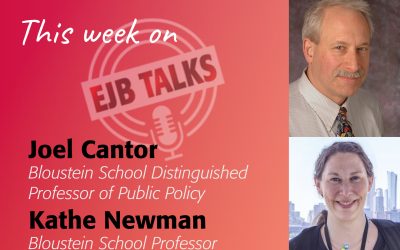

This week on EJBTalks Stuart Shapiro talks to two amazing Bloustein alums, Leah Apgar and Joe Palazzolo, who work at New Jersey Community Capital (NJCC), a community development financial institution. Leah and Joe share the history and typical work of the organization, which was established in 1987 as an affordable housing lender and has grown into a financing institution involved in all types of community development and commercial lending projects. They talk about how the pandemic and economic shutdown required their institution to pivot its work to assist suffering small businesses. They began considering all small businesses and nonprofits in the state as underserved and started the Garden State Relief Fund (GSRF) as a remedy. They conclude with a discussion about where NJCCs work goes from here, and how the GSRF will remain in place to adapt to assist NJ small businesses as the economy continues to recover.
Stuart Shapiro
Welcome to EJB Talks. I’m Stuart Shapiro, the Associate Dean of Faculty at the Bloustein School, and the purpose of this podcast is to highlight the work my colleagues and our alumni in the fields of policy, planning and health are doing to make the world the country and New Jersey a better place. Today, we’re very happy to be speaking with Leah Apgar and Joe Palazzolo, from New Jersey Community Capital. NJCC is one of the most popular destinations for Bloustein graduates, including Leah and Joe, who both graduated from our Public Policy Program. Welcome to the podcast.
Leah Apgar
Thanks.
Joe Palazzolo
Thank you.
Stuart Shapiro
Can you tell us a little bit about what NJCC is, what your mission is, and what you do?
Leah Apgar
Yep, absolutely. So New Jersey Community Capital, NJCC, we are a community development financial institution that’s a CDFI. We’ve been around since 1987, and we’re certified by the Department of Treasury. So you can think of us sort of like a nonprofit bank. And so we provide all types of community development, financing for different projects throughout the state of New Jersey. And we really focus on projects that can’t be financed by traditional financial institutions, or mainstream banks. So we started as an affordable housing lender in 1987. And then we grew into financing all different types of community development projects.
So early education centers; think about headstart centers, charter schools, community facilities, economic development projects. And mostly what we’ve done historically is real estate lending. So when you think about that, the construction of actual projects. So the construction of this affordable housing project, and different things like that. Most of those loans are to nonprofit organizations. So nonprofits just like NJCC, as well as mission-oriented for profits. And then in addition to our lending, we do also have several other lines of business. So we do a lot of real estate development as well. And we have a program that modifies defaulted residential mortgages. But commercial lending really is our primary line of business at New Jersey Community Capital.
Stuart Shapiro
Wonderful. And I want to get into the sort of rationale for that and why you do that a little bit. But let me first turn to the pandemic, which has been the focus of a lot of our podcasts. You’ve both been at NJCC for a while now. How did things change in March of 2020 when the pandemic hit and then perhaps even more relevantly for you guys the deep recession, and this weird kind of recovery that we’ve had since then?
Joe Palazzolo
Yeah, well, to your first point, about us being at NJCC for a while, Leah and I’ve been here for almost 15 years. And you know, it’s like you said in the intro, what better place for two Bloustein and alumni the land than NJCC. Not only do we get a chance to put the material that we learned in the MPP programs to work for New Jersey’s families and New Jersey’s communities, but NJCC is only a few blocks from Civic Square. So it feels like we’re at home.
Stuart Shapiro
I will say you’re making me feel old with that. ((laughing))
Leah Apgar
((laughing)) Well, We both had you as a professor.
Stuart Shapiro
((laughing)) Yup I remember. Two excellent students.
Joe Palazzolo
Thank you. Thank you. You know, we do have this long-term view of NJCC and its work. And because we have that view, we can tell you things change in a significant way when the pandemic hit. We all know that our individual lives changed, everything from wearing masks to working remotely to physical distancing, and all those hallmarks of a national and really a global individual-level response to the pandemic. But our work changed too. Leah and I and the team that we work on, work within our lending department. We usually spend a lot of time structuring deals and working through some of these thorny legal issues related to tax credits and accessing federal and state subsidies to build affordable housing and opportunity-related housing, community buildings, and so on. Well, a lot of that stopped in an unexpected way.
And part of that stop was the move to remote work for the entire industry. But part of it was that our market our industry of opportunity-related finance was, we were just stunned. You know, we had not before been in an environment where an entire economy shut down. Our closest comparison was the aftermath of Superstorm Sandy when most of the entire Jersey shore was closed, along with the devastating physical damage as far north as Hudson County and wrapping all the way around the horn to as far inland as parts of Gloucester County. But that was in a sense, a very temporary event. Sandy hit on October 28 in the evening and lasted a couple of days. Then a few days later, we had a massive snowstorm, and then it was time to rebuild.
The pandemic was different in that everything just stopped. And for our borrowers and our small business borrowers especially, that was devastating. Of course, as you know, about half of New Jersey’s workforce is employed by small businesses. And that was a complicating factor because not only did our small business borrowers no longer have revenue coming in, but now their employees had no source of income and needed assistance for their own personal and their own family needs. All of which led to the recession that you asked about, and that in New Jersey, in many ways, was feeling in a real and substantive way up until recently, and is still feeling in certain parts of our economy.
Stuart Shapiro
Yeah, absolutely. So what did you do? I mean, what was the reaction? And what changed at NJCC?
Leah Apgar
Yeah, so maybe I could give you a little bit of background on what Joe was talking about, what we’ve done historically for small business lending, and then that will bring us to today. And we can talk a little bit about what our response to the pandemic has been. And so as Joe was talking about, we’re not traditionally a small business lender. We’re really a real estate lender, we’re accustomed to dealing with these really large projects. And so at the time of Superstorm Sandy, we quickly launched a program. For that program, we recognized that small business, as Joe was saying they had significant closures, damage, things like that. And so we launched a program within a month of that storm. And we did 60 small business loans totaling about $3.5 million. And that was really important to us. And it was important for us to gain that experience on a quick response to a crisis.
And we continue to do some small business lending since Superstorm Sandy. So that was nine years ago. So over the past nine years, we continue to do small business lending in communities where we were already doing other community development work. So say we’re financing this affordable housing project here, this charter school over here. And now there are these two or three small businesses in this same neighborhood that are looking for financing We would do small business financing for those businesses on a one-off basis. And then March 2020, comes along, and the pandemic happens. And so you know, what is going to be our response to the pandemic? And what will be our response for small businesses? And I’m going to let you talk a little bit to Joe about what that has looked like for us.
Joe Palazzolo
So for us, it’s the Garden State Relief Fund. We call it GSRF because, you know, we live in a world of acronyms in the CDFI space. We started this as a way to provide socially motivated investors with an opportunity to rapidly put their money to work in communities and for businesses that were disproportionately impacted by the pandemic. So as we pitched it to our investors, we called it a financial first responder style fund that could move capital very quickly and efficiently from the investor to NJCC and then from NJCC to the people in the businesses who needed the most.
The GSRF program, offers low-interest loans. They’re primarily styled as working capital lines of credit. The dollar amount of the loans range from 10,000 to 75,000. Though we do talk to borrowers about other amounts, if it’s necessary, it really depends on the situation. GSRF loans, have a 36-month term, so they’re not really designed to become part of the business’s equity capital stack. Instead, the loans are designed to get the business through the pandemic. And I’ll talk more about the difference between bridging capital and then filling gaps in just a moment. The maximum interest rate on these loans is 3%. Though in some parts of New Jersey interest rate is actually 0% for a GSRF loan.
We designed the program to provide no payments for the first six months of the loan, which was right during the heart of the pandemic. So it allowed businesses with no revenue sources to not have to worry about paying us back. And then after those six months, the GSRF loans were fully amortized over the remaining term of the loans. The few things I guess to note about the need for GSRF; first, more than half of New Jersey small businesses self-report that they only had enough cash to operate for between zero and three months without consistent revenue streams. So you need a loan program like this because between zero to six months if there was nothing that came in these businesses would extensively close.
And then second, and you know, my comment I made earlier about half of New Jersey jobs coming from small businesses, that’s not an insignificant number. The real number there is 1.8 million private-sector jobs. And particularly concerning for NJCC is that about 10% of New Jersey’s workforce is employed by the nonprofit sector which also needed a disproportionate amount of support during the pandemic, particularly the early stages of the pandemic. So with that as context, happy to talk about goals for the GSRF if you’re interested.
Stuart Shapiro
Absolutely. And talk to me a little bit about the response. What kind of take-up rates if you had, and if you want to throw in stories of successes, that’d be great, too.
Joe Palazzolo
Okay, so maybe I’ll talk about the goals of the program, Leah… and then you can go into the rates, okay.
Leah Apgar
Sure, go for it.
Joe Palazzolo
So, a couple of goals we had for GSRF. First, in our traditional non-pandemic work, we typically bridge gaps in projects. And that means that we provide financing that helps carry a project to completion. Well, with the GSRF, we didn’t really want to bridge any gaps, instead, we wanted to fill revenue gaps. So it’s a little different. To do that we had a cast a wider net because there was just more need. Wider than we normally cast for our lending programs. So prior to the pandemic, we might have been focused more on historically underserved geographies and populations. With an entire economy being shut down and with so much of New Jersey’s workforce without a source of income, we considered all small businesses and all nonprofits in the state to be an underserved community in the aggregate. So that means that we were filling revenue gaps for businesses located in areas where we haven’t worked before, and to borrowers with a profile that did not look or feel like the usual NJCC borrower. So that was the first goal, fill those revenue gaps to keep businesses in business.
The second goal was to leverage existing programs, you know, to the extent that we could leverage those programs. So for example, you have the paycheck Protection Program, PPP, which provided partially forgivable loans to small businesses so that they could retain their employees. Well, in those scenarios, and we had a few of them, I Leah’s going to talk a little bit about them. In those scenarios where a business was in the process of obtaining PPP financing, then yes, we did not seek to fill a gap, but instead, we went back to our traditional approach of kind of bridging the gap. And the bridge we wanted to build was from the point of application to the point where PPP funds were received. We had some GSRF borrowers who fit that bucket where they needed our funds to get them to the point of receiving PPP funds, which is always going to be a better option because the PPP funds are partially forgivable.
I think that’s something that I’d be remiss if we didn’t note, while we’re talking. With organizations like NJCC, in the private sector, you might see cutthroat competition to keep borrowers in the portfolio once you acquire them. Well yeah, NJCC likes to keep its borrowers and build long-term relationships, and we think we provide better capital and we’re faster and more efficient and all that. But we’re critically aware that we’re not always the best option for a borrower. And if a small business has to choose between the money you have to repay with interest, even if it’s 3% interest to our GSRF program or money that’s partially forgiven in a PPP program loan, well you should take the PPP money every time. And we encouraged many applicants to do that.
And then maybe the final goal and this might be a good lead-in for Leah, about the program and take-up rates. It’s something that emerged for us was that we found ways through this program to strengthen our existing partnerships with other big players in the community. For example, we partnered with the New Jersey Econobmic Development Authority. They provided us with a $5 million first loss performance repayment guarantee for those socially motivated investors who invested in GSRF, which allowed us to bring in more investors than we normally would. Another partnership that we had a chance to really advance on was with the Pascale Sykes Foundation, which allowed us to offer 0% interest for loans in their catchment area, which of these four counties down in the southern part of New Jersey.
We also developed additional relationships with the city of Trenton. We built a $2 million UEZ style loan program within the GSRF portfolio for Trenton. We also reengaged with the city of Asbury Park, and we actually repurpose some old Superstorm Sandy loan-loss guarantee funds to provide guarantee opportunities for small businesses related to the pandemic in the city of Asbury Park. So, you know. rekindling and growing and strengthening some of those connections. That was a good outcome for us from GSRF too and then I think Leah, you want to talk about the take-up rate?
Leah Apgar
So in GSRF, you know, we received 650 applications in 15 months. That is a lot of loan applications, especially Yeah,
Stuart Shapiro
Wow. How many people do you have reviewing those?
Leah Apgar
Our lending team has about seven people. So we did have a person working specifically on loan intake as well, which was really helpful. But yes, we received 650 loan applications. Unfortunately, many of those businesses weren’t viable. They didn’t qualify for the program, things like that. So we were really looking for the business like Joe was saying that was successful before the pandemic, and then they need this, you know, to fill this gap in their operating because they’ve got overhead operating expenses that are fixed, you have decreased revenue. And so you’ve got to somehow fill that gap to fund your operations during this time period. So we’re really looking for that business that was successful before the pandemic and needs this loan to get them through the pandemic.
And so we’ve closed about 130 loans totaling around $6 million or so. And well over half of those loans have been in the foodservice industry. Actually, I will say we’ve finance about eight restaurants in New Brunswick. So we are happy to say that we are keeping the New Brunswick restaurant industry alive around our office and around Bloustein. We’ve financed many childcare centers, professional services, recreation. So think about all of those businesses that have really been closed and greatly impacted because of the pandemic.
So one example is a nonprofit that we provided a $25,000 loan. So they are a nonprofit called neighbor plus, in Palisades Park, New Jersey. And they provide many social services. So food donation, health counseling, programs for single mothers education programs, all different types of social service programs. And because of the pandemic, as you might expect, they had to cede some operations, they had to convert some of their services to a remote basis. So they had to think about how do we reorient our business strategy, so being a nimble nonprofit, how do we change what we’re doing to make it work now during the pandemic? And so we provided them with a loan for working capital to change some things about their business strategy, and also to provide for salaries for their employees, so they could keep people employed during the pandemic. And I’m happy to say they really rebounded, so they actually repaid their loan in full.
And this has been something that we really did not expect when we started this loan program. So you start these programs, we have the same experience with Superstorm Sandy, you don’t know what’s going to happen. You can’t, you know, you don’t have your crystal ball, you can’t see the future. So you’re making these loans, and you’re making the best decisions that you can but you don’t, you don’t know, right? Because we don’t know how businesses will get through this time. And so we’ve actually had more than 10% of that loan portfolio, or about 17 loans repay in the past year, and particularly over the past few months. And I think that really shows the resilience of many small businesses. That wasn’t something we expected, early repayments, and we haven’t had any defaults, either in the portfolios. And that’s also been really exciting for us.
Stuart Shapiro
That’s fantastic. I want to talk about the future a bit. But first, I did have one question about something you said. I know the paycheck protection stuff and also all the many other relief statutes passed in Washington, obviously cover some of the same ground, but who did they leave out that you found coming to you because they weren’t eligible for those types of programs?
Leah Apgar
Yes, so and I’ll let Joe comment on this as well. I think where people ran into, our businesses ran into challenges was where they were small, and didn’t necessarily have an established lending relationship. So it was hard for them to get in somewhere. So especially with the first round of PPP. So I think it got better with the subsequent rounds. But especially with the first round, I know even NJCC, we’re a pretty significantly sized nonprofit organization, a financial institution, and we even had to go to several of our banking relationships until we were able to get into the PPP process ourselves. And so it was happening so quickly that if you didn’t have all of your documentation ready; tax returns, whatever documentation was required to apply for PPP. If you didn’t have all of your ducks in a row on that, and you didn’t have an established banking relationship, it just happened too quickly for many of those very small businesses to be able to get into the program.
At least on the first round. And like I said, it did get significantly better. NJCC, we do not provide PPP loans directly. We’re not certified to do that, but we were able to, on the most recent round of PPP to partner with Customers Bank, and establish a portal so that some of our borrowers were able to get access to PPP financing through Customers Bank. And so that was really exciting to us, because many of our borrowers are very small, both our nonprofit borrowers and our small business borrowers. And that was a way for them to get into the process and into the program and to serve some of those smaller businesses. Joe, I don’t know if you have anything to add to that feel free?
Joe Palazzolo
Sure. You know, a couple of things. There was a gap when it came to businesses that had no employees. So the smallest of small businesses that are maybe someone’s side business that they do on Etsy, or someone’s weekend kind of businesses. They’ve been left out up until even recently. I think it’s only been recent that even the NJEDA and their phase four grant program has now opened up some grant funds, although a very small amount of grants. I think it’s capped at maybe 10,000, for the smallest of small businesses, which you know, after 15 months, 10,000 may not be enough to salvage some of those smallest of small businesses. I’m happy to talk for a minute about Leah’s comment about traditional banks and not have an existing relationship. And I know, you know, one of the ongoing questions is, why can’t, why couldn’t these businesses access those traditional banks?
Well, I think it’s really a matter of capital sourcing. Prior to the PPP program and EIDL programs, other ones came out versus post those programs. So traditional banks, get their funds from a variety of sources, not the least of which is consumer accounts from their customers, you know, checking accounts, savings accounts, investment vehicles, like CDs, and so on. Banks don’t necessarily sit on those funds, and then utilize another source of capital to make loans, they use those funds to make loans to the same local small business community that they get those accounts from. And when banks are playing with that money, which maybe you call that the house money, then they have an obligation to be more conservative with how they might deploy those funds. And they have this obligation because they have a commitment to their customers to not utilize their funds in a risky way.
So when you have a source of capital that by its very nature has to be redeployed in a conservative manner, it’s hard for a bank to look at a small business in a pandemic, and then be enthusiastic about giving them a loan. So imagine that borrower profile. You walk into…that’s like a bad joke setup… you walk into a bank and you tell them that, hey, my business is closed, and in some cases, you’re mandated to be closed by the state government, like Jim’s work, for example. And then my business can operate past a certain capacity like restaurants were capped at a certain capacity. And my only source of income is my customers who are also out of work. And I need a loan for about 50,000 so I can pay my suppliers and pay my rent, really not a great proposition for the bank to say, yeah, I’ll give you a loan.
And then on the other hand, when you look at when PPP came out, and the IDL came out, once those programs were available, that source of capital was less risky for the banks because it wasn’t really from their customers. It’s from the federal government. So when traditional banks are using federal government funds, then they have more of an ability to meet the needs of the larger community. And because of that capital sourcing is just a mismatch between the type of funds traditional banks have readily available when a pandemic would start at the beginning, versus the type of funds they have available once the government programs were enacted.
Stuart Shapiro
So let me end with a what now question. You know, you’ve established these programs, you’ve expanded into areas you did not loan in before, or lend in before. So what does this mean for NJCC coming out of the pandemic, and hopefully, soon coming out of the recession?
Joe Palazzolo
Sure. I mean, Leah, maybe I’ll give it a shot, and if you want to jump in…
Leah Apgar
Yeah, sure.
Joe Palazzolo
I think programs like the GSRF think they’re gonna stick around for a bit. We can look for our own experience that at our rebuild New Jersey fund that Leah referenced before that post-Superstorm Sandy fund that still exists today. And like Leah said, we’re nine years out almost 10 years out from that storm. So it’s just a matter of repurposing the funds as time goes on. So our initial Sandy loans, I think they were capped at something in the range of like, 50,000. Then about six to eight months after the storm, we began making much larger loans in the range of half a million dollars out of that fund.
And then we started extending the terms of those loans from 12 to 18 months up to now five years and beyond. And then we started talking to the investors in that fund and saying, hey are you interested in supporting the larger small business community? And they were. So we repurposed the intent of that loan fund to be from Sandy relief to small business opportunity, and I think the same is going to be with GSRF. Although we’re not there yet, you know, there’s still significant damage that we’re trying to ameliorate with this loan fund in New Jersey. We’re not going to see the same level of federal funding programs like PPP is going to go away the EIDL. All that’s going to be reduced down to pre-pandemic conditions at some point. But loan programs like the GSRF, they’re going to remain in place, and they’ll change and they’ll adapt as the economy continues to recover and improve.
Leah Apgar
Yeah, I agree with you, Joe. I mean, that’s excellent. You know, our job as a CDFI is to respond to the needs of businesses and the community and to fill those gaps. And so, those needs will change as we come out of the pandemic. And so we’ll figure out how do we change and repurpose some of the money that we have available to respond to what the new needs are. I think that certainly right now, we’re still very much responding to operating shortfalls and those types of gaps to small businesses, but we’ll start to see certainly a change in what’s needed, I’m sure. And we’ll respond to that. And also, I think we’ll start to see businesses that are changing their business model as well as a result of the pandemic and how we can help some of those businesses and financing some of those changes, too.
Stuart Shapiro
Wonderful. Well, thank both of you for a very illuminating conversation, not my area of expertise, and I learned a lot so thank you.
Leah Apgar
Thank you.
Joe Palazzolo
Thank you.
Stuart Shapiro
Also a big thank you to our production team, Amy Cobb and Karyn Olsen. We will see you in two weeks on our summer schedule with another talk from another expert from the Bloustein School. Until then, stay safe.




